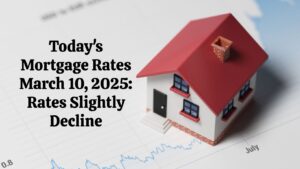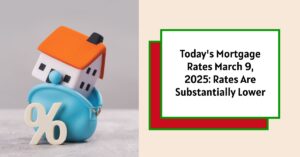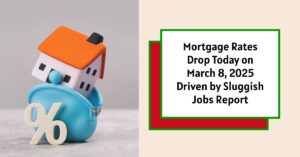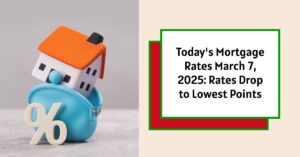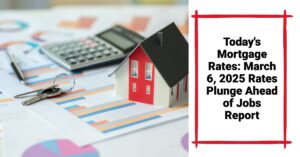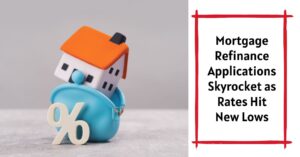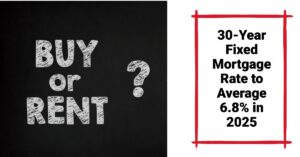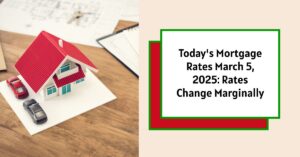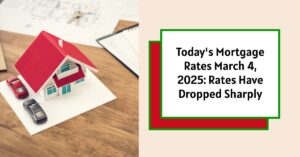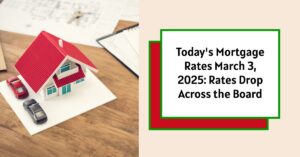Today, March 10, 2025, mortgage rates have experienced a slight decrease, providing new opportunities for homebuyers and homeowners looking to refinance. The average rate for a 30-year fixed mortgage currently stands at 6.31%, while the 15-year fixed rate has dipped to 5.63%. While these rates represent a minor decline, they remain above 6%, suggesting this trend may continue for the foreseeable future.
Today's Mortgage Rates – March 10, 2025
Key Takeaways
- Current Mortgage Rates: 30-year fixed mortgage at 6.31%, 15-year fixed at 5.63%.
- Current Refinance Rates: 30-year fixed refinance at 6.33%, 15-year fixed refinance at 5.56%.
- Rates are expected to remain high compared to the historic lows experienced during the pandemic.
- Homebuyers and current homeowners should consider securing rates now rather than waiting for further decreases.
It’s essential to have an updated view of the market before making any home buying or refinancing decisions. Here’s a detailed overview of the current mortgage rates:
| Loan Type | Current Rate (%) |
|---|---|
| 30-year Fixed | 6.31 |
| 20-year Fixed | 6.06 |
| 15-year Fixed | 5.63 |
| 5/1 ARM | 6.03 |
| 7/1 ARM | 6.30 |
| 30-year VA | 5.77 |
| 15-year VA | 5.20 |
| FHA Loans 30-year | 6.01 |
Source: Zillow
While the slight drop in mortgage rates may provide hope, the period of mortgage rates consistently hovering above 6% appears to be the new norm. Homebuyers accustomed to historically low rates during the COVID-19 pandemic will need to adjust their expectations as the market stabilizes at these higher levels.
Current Refinance Rates Today
Refinancing offers a strategic opportunity for homeowners looking to get better rates or adjust their mortgage terms. Here are the average refinance rates:
| Loan Type | Current Rate (%) |
|---|---|
| 30-year Fixed | 6.33 |
| 20-year Fixed | 6.09 |
| 15-year Fixed | 5.56 |
| 5/1 ARM | 6.12 |
| 7/1 ARM | 6.19 |
| FHA Loans 30-year | 6.01 |
| 30-year VA | 5.68 |
Understanding the variance between mortgage and refinance rates is crucial, as borrowers often find refinancing rates to be slightly higher. This could affect your decision-making process. If you are considering refinancing your mortgage, it is vital to analyze whether the potential savings outweigh the costs associated with refinancing.
Monthly Payments Under Current Rates
Knowing how mortgage rates translate into actual monthly payments can significantly impact borrowers' financial plans. Below are the estimated monthly payments for various mortgage amounts based on both the current 30-year and 15-year fixed rates.
Monthly Payment on $150,000 Mortgage
- 30-Year Fixed (6.31%): Approximately $932 per month
- 15-Year Fixed (5.63%): Approximately $1,208 per month
Monthly Payment on $200,000 Mortgage
- 30-Year Fixed (6.31%): Approximately $1,243 per month
- 15-Year Fixed (5.63%): Approximately $1,609 per month
Monthly Payment on $300,000 Mortgage
- 30-Year Fixed (6.31%): Approximately $1,859 per month
- 15-Year Fixed (5.63%): Approximately $2,472 per month
Monthly Payment on $400,000 Mortgage
- 30-Year Fixed (6.31%): Approximately $2,474 per month
- 15-Year Fixed (5.63%): Approximately $3,295 per month
Monthly Payment on $500,000 Mortgage
- 30-Year Fixed (6.31%): Approximately $3,079 per month
- 15-Year Fixed (5.63%): Approximately $4,098 per month
These calculations are estimates and can vary based on location, lender terms, and the specifics of each borrowing situation. However, these figures give prospective buyers a clearer picture of what to expect with their monthly financial commitments.
The Importance of Shopping Around for Rates
In today’s market, where rates fluctuate frequently, it’s crucial to shop around and compare different lenders. Although the average rates give a good initial understanding of the market, individual offers can vary significantly based on a borrower’s credit score, down payment, and overall financial profile.
- Credit Score: A higher credit score can potentially lower your interest rate. Lenders reward those with better credit by offering more favorable mortgage terms.
- Down Payment: A larger down payment often leads to lower interest rates since the lender sees you as less of a risk.
- Debt-to-Income Ratio: Lenders look at your total debt-to-income ratio when determining your eligibility for a mortgage. Keeping this ratio low could aid in securing better rates.
Understanding Adjustable-Rate Mortgages (ARMs)
As the market evolves, many homeowners are exploring various mortgage types, including adjustable-rate mortgages (ARMs). These loans offer lower initial rates compared to fixed-rate mortgages but come with the potential for fluctuating rates in the future, making them a riskier option for some.
- 5/1 ARM: With rates around 6.03%, this ARMs provides a fixed rate for the first five years, after which the rate can adjust yearly based on market conditions. This could be a strategic choice for buyers planning to sell or refinance within the fixed-rate period.
- 7/1 ARM: Similarly, the 7/1 ARM retains a fixed rate for seven years, currently at 6.30%. Again, this helps buyers lower their initial payments.
If you’re planning to stay in your home for a short time, a fixed rate may not be necessary, as ARMs often provide lower monthly payments during the initial fixed-rate period.
The Influence of Federal Policies on Mortgage Rates
The Federal Reserve plays a critical role in shaping mortgage rates through its monetary policy decisions. Currently, the Fed has indicated a deliberate pause in any interest rate cuts, as articulated by Chairman Jerome Powell. This is not just a whim, but a strategic decision based on various economic factors.
Key Factors Influencing the Fed's Position
- Uncertainty Surrounding Government Policies: Changes under the Trump administration, particularly those related to trade, immigration, and fiscal policies, have introduced significant unknowns into the economic landscape. This uncertainty can lead businesses to hesitate in making major investments.
- Solid Economic Indicators: Despite the described uncertainties, indicators suggest ongoing job growth and manageable inflation levels. This solid performance provides the Fed with a buffer against immediate rate cuts.
- Demand for Clarity: The Fed aims to identify real economic signals amidst temporary market fluctuations. Powell emphasizes the importance of not rushing into cuts without clearer indicators of the economic landscape.
By maintaining current interest rates, the Fed aims to balance economic growth while managing inflation risks. Lower interest rates can stimulate borrowing, thus potentially fueling inflation if demand significantly increases.
Recommended Read:
Mortgage Rates Trends as of March 9, 2025
Mortgage Rates Drop: Can You Finally Afford a $400,000 Home?
Mortgage Rates Forecast March 2025: Will Rates Finally Drop?
Expect High Mortgage Rates Until 2026: Fannie Mae's 2-Year Forecast
The Broader Economic Impact of the Fed's Decisions
The Fed's monetary policies have ripple effects across various sectors of the economy, influencing everything from home buying costs to savings accounts. Here’s how their decisions typically manifest:
- Mortgage Rates: A decrease in interest rates often translates to lower mortgage costs for homebuyers, making homes more affordable.
- Consumer Spending: Lower interest rates on credit can stimulate consumer spending, a major driver of economic growth. Conversely, higher rates could dampen spending, leading to economic slowdown.
- Business Investments: The cost of borrowing for businesses is significantly influenced by interest rates. A stable rate encourages investments in new equipment and expansion, fostering economic growth.
In maintaining current rates, the Fed is leveraging an approach that could lead to a more stable financial environment, allowing for considered growth without rushing into decisions that could create volatility.
Personal Insights on the Current Market
From an industry perspective, the current mortgage rates, though slightly improved from earlier in the month, reflect ongoing economic conditions and consumer sentiment regarding home buying. The modest decrease in rates may not seem substantial, but for many looking to buy homes or refinance, every basis point counts.
Many prospective homebuyers are feeling squeezed between rising home prices and high rates. However, those who are financially prepared and can navigate this landscape might find opportunities among sellers who are willing to negotiate.
The uncertainty from government policies further complicates these dynamics but could also lead to increasingly competitive rates as markets adjust to new realities. Buyers should approach the market cautiously and remain informed about potential changes in both rates and government policies that could influence their financial decisions.
Final Thoughts
In today's market, the mortgage rates as of March 10, 2025, reflect a minor decline, encouraging buyers to explore their options. However, venturing into the market now might be wise, as rates are not likely to see dramatic decreases in the near future.
Homebuyers are encouraged to assess their individual financial situations, shop for the best possible mortgage products, and remain vigilant about changes in both direct market influences and overarching economic policies. With the right preparation and knowledge, securing the best mortgage rates can still be within reach.
Work With Norada, Your Trusted Source for
Real Estate Investments
With mortgage rates fluctuating, investing in turnkey real estate
can help you secure consistent returns.
Expand your portfolio confidently, even in a shifting interest rate environment.
Speak with our expert investment counselors (No Obligation):
(800) 611-3060
Recommended Read:
- Mortgage Rate Predictions 2025 from 4 Leading Housing Experts
- Mortgage Rates Forecast for the Next 3 Years: 2025 to 2027
- 30-Year Mortgage Rate Forecast for the Next 5 Years
- 15-Year Mortgage Rate Forecast for the Next 5 Years
- Why Are Mortgage Rates Going Up in 2025: Will Rates Drop?
- Why Are Mortgage Rates So High and Predictions for 2025
- Will Mortgage Rates Ever Be 3% Again in the Future?
- Mortgage Rates Predictions for Next 2 Years
- Mortgage Rate Predictions for Next 5 Years
- Mortgage Rate Predictions: Why 2% and 3% Rates are Out of Reach
- How Lower Mortgage Rates Can Save You Thousands?
- How to Get a Low Mortgage Interest Rate?
- Will Mortgage Rates Ever Be 4% Again?
